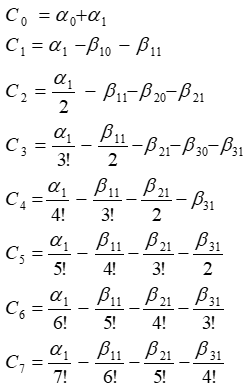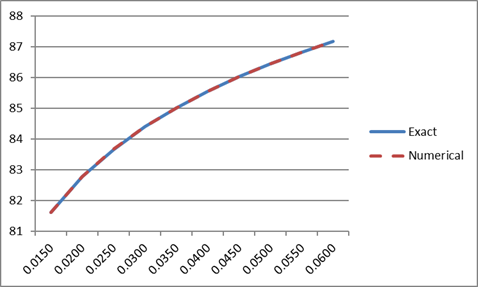Application of Implicit One-step Third Derivative Method for the Solution of Temperature Gradient in a Fish Chunk Placed in a Smoking Kiln.
- Olumurewa O. K.
- 141-147
- Feb 12, 2024
- Mathematics
Application of Implicit One-step Third Derivative Method for the Solution of Temperature Gradient in a Fish Chunk Placed in a Smoking Kiln.
Olumurewa O. K.
Department of Mathematical Sciences, Federal University of Technology, Akure. Ondo State.
DOI: https://doi.org/10.51584/IJRIAS.2024.90112
Received: 13 December 2023; Revised: 08 January 2024; Accepted: 12 January 2024; Published: 12 February 2024
ABSTRACT
This paper described numerical solution of temperature gradient in a fish chunk placed in a smoking kiln, using an implicit one-step third-derivative numerical method which was developed by introducing more derivative properties into the conventional linear multistep method.
The heat transferred from the furnace generated by the biomass through the metal plate to the drying chamber by conduction, to the fish chunk in the smoking kiln was evaluated by the Fourier first heat flow equation.
Comparison of the numerical result with the exact solution showed that the implicit one–step third- derivative method was accurate and thus recommended for solving Engineering problems resolving in differential equations.
Keywords: Temperature gradient; Fish chunk; Smoking-kiln; Implicit; One-step method; Third Derivative, Differential Equation.
INTRODUCTION
In many African countries, Agriculture employed about 80-90% of the working population and represents the largest part of the economy, Okonta and Ekelemu (2005). In spite of this, the quantity of agricultural products that are produced could not meet up with the demand of the people due to poor storage facility and preservative measures. One major example of such product is fish and fishery products.
In developing countries, fish is one of the potential sources of animal protein and essential nutrients for the maintenance of healthy body, Fawole et al., (2007). In recent years, fish has become favorite foodstuff for the majority of societies because of health reasons, Ali and Kiumars (2010). However, quality of harvest is markedly affected by the ease of deterioration and spoilage in fresh fish.
Fish is a very perishable food; this has been the main obstacle in its preservation. Fish begins to deteriorate as soon as they leave water. Spoilage starts as soon as a fish dies as a result of a complex series of chemical, physical and bacteriological changes that occur in the muscle tissue. Hence, preservative measures are important immediately after harvest to extend shelf life and prevent economic losses, Okonta and Ekelem (2006).
Smoking is the oldest and most common method of fish preservation in developing countries Kumolu-Johnson et al., (2010). Fish are smoked to reduce packaging cost, lower weights, enhance appearance, retain original flavor and maintain nutritional value, Baysal et al, (2003) and Demir et al., (2007).
In solving problems of smoking, usage of renewable energy technologies has received considerable attention within the past years for their potential to help meet basic needs in many countries, Akanbi and Adeyemo (2006). The biomass fuelled smoking equipment meets the challenges encountered by fish farmers because of the abundance of simple and affordable combustion devise such as sawdust, kernel shell, rise husk, charcoal, e.t.c. which are common sources of energy in rural areas of developing countries.
In the process of smoking, as a result of heat transfer to the fish chunk, a temperature gradient develops within the solid while evaporation occurs from the surface. This produces a migration of moisture from within the fish chunk to the surface, which occurs through one or more mechanisms, namely diffusion, capillary flow, internal pressures set up by shrinkage through a repeated and progressive occurring vaporization and re – condensation of moisture to the exposed surface. The temperature gradient set up in the fish chunk will also create a vapour-pressure gradient, which will in turn result in moisture vapour diffusion to the surface, this will occur simultaneously with liquid moisture movement.
Nutritive qualities of biological materials are affected by temperature during smoking therefore determining the temperature gradient of a fish chunk is an indication of effect of temperature on the properties of the fish at different segments, Famurewa et al., (2014).
Numerical method is a very effective and essential tool in food preservation techniques, literature reveals that Maggiolo et al., (2005) used finite element method to solve the algebraic set of equations that defined the phenomena of heat and mass transfer involved in drying preservation of food, Habibeh et al., (2021) in a study simulated the drying process of garlic slices based on numerical method and Shahari (2012) in a study used a numerical solution technique based on the method of lines with local finite difference method approximation to quantify the drying of food products, to mention a few.
This study will apply the implicit one-step third derivative numerical method to determine the temperature gradient in a fish chunk hence, the exact temperature (T)0C that will dry a particular size (X)m of fish chunk in order to retain the nutritive qualities.
METHODS
Chunks of African catfish, Clarias gariepinus, of length 6cm and diameter 5cm, were smoked in a biomass fuelled smoking kiln (FUTA Model) at smoking chamber temperature of . The heat transferred through the fish chunks by conduction was evaluated by Fourier’s heat flow equation;
…. . . . . . .(1)
Q is the conduction heat flow (KJ)
K is the thermal conductivity of material (KJ/Kg0C)
A is the fish chunk surface area (m2)
is the change in temperature (0C) with respect to length (m).
Famurewa (2011) in a study improved on the accuracy of the conventional Linear Multistep Method by introducing more derivative properties and also discovered in another study as revealed in Famurewa (2011) that the one–step third derivative method yielded a more accurate result hence recommended the method for solving problems of first order differential equation.
The Implicit one- step third derivative numerical method of the form;
. . . . . (2)
was adopted for the solution of the temperature gradient.
Derivation of the Numerical Method
Theorem
Setting k=1, l=3 in the generalized implicit multi-derivative linear multistep method of the form:
– – – – – (3)
Famurewa and Olorunsola (2013)
gives a one-step third derivative method of the form;
. . . (4)
Proof
Setting k=1, l=3 in (3) gives
. . . (5)
with local truncation error
. . (6)
Adopting Taylor’s series expansion of in (6) and combining terms in equal powers of h gives

that is;
where

Imposing accuracy of order 7 on En+1 to have
C0 = C1 = C2 =C3 = C4 = C5 = C6 = 0 and En+1 = 0(h7)
which gives
Solving gives;
putting these values into equation (5) gives the one – step third derivative method of equation (4).
Implementation
To access the accuracy of the scheme, the method was re-written in FORTRAN programming language and implemented on a digital computer. The program was used to solve the heat flow equation.
Problem;
*Note: the negative sign is only showing the direction of heat flow.
the fish chunk is cylindrical in shape, A=2πrx, . . . (9)
substituting for A in (1) and integrating gives
(where C is a constant) . . . (10)
Substituting
Q = 1.081142857 (KJ) and Diameter of Fish chunk = 5cm = 0.05m (measured),
K for Fish = 1.72 (KJ/Kg0C) (ASHRAE, 1989)
(measured);
Exact solution; . . . (11)
RESULTS
Table 1: The Result Obtained for the Solution.
| xn value(m) | Exact-Solution (T)0C | Computed-Solution (T)0C | Error |
| 0.0150 | 81.621860428480289000 | 81.621913580246911000 | 5.315177e-05 |
| 0.0200 | 82.772588718287409000 | 82.772646604938274000 | 5.788665e-05 |
| 0.0250 | 83.665162923544244000 | 83.665221604938282000 | 5.868139e-05 |
| 0.0300 | 84.394449150720064000 | 84.394508024691376000 | 5.887397e-05 |
| 0.0350 | 85.011051870029107000 | 85.011110803368993000 | 5.893334e-05 |
| 0.0400 | 85.545177440527198000 | 85.545236395570157000 | 5.895504e-05 |
| 0.0450 | 86.016309583152719000 | 86.016368547204820000 | 5.896405e-05 |
| 0.0500 | 86.437751645784033000 | 86.437810613962938000 | 5.896818e-05 |
| 0.0550 | 86.818992365001336000 | 86.819051335225140000 | 5.897022e-05 |
| 0.0600 | 87.167037872959853000 | 87.167096844264094000 | 5.897130e-05 |
Figure 1: Graphical Representation of the Result
DISCUSSION
The result and error analysis of the numerical method were presented in Table 1 and Figure 1. The temperatures at different thicknesses of the fish chunk were iterated over the entire length of the chunk. It was observed that the computed result was very close to the exact solution, this is a proof of the accuracy of the method to solving other practical Engineering problems that resolve into first order ordinary differential equations.
CONCLUSION
In this study, implicit one – step third derivative numerical method was used to determine the temperature gradient in a fish chunk using a biomass fuelled smoking kiln. The numerical result showed the smoking temperature for the different thickness of the fish chunk. The result obtained showed that the numerical method was accurate, effective and efficient, hence, could be adopted in solving practical problems as was recommended in Famurewa and Famurewa (2015).
Plate 1: Biomass Fuelled Smoking Kiln used for the Study
REFERENCES
- Akanbi, C. T. and R. S. Adeyemi, (2006). “Drying Characteristics and Sorption Isotherm of Tomato Slices.” Journal of Food Engineering 73(2): 157-163.
- Ali, A. and P. Kiumars, (2010). Chemical and Proximate Composition Properties of Different Fish Species Obtained from Iran. World J. Fish Marine Sci., 2:237-239. American Society of Heating, Refrigerating and Air Conditioning Drying in Africa — Proceedings of Food Drying Workshop, Dakar, Senegal
- Baysal, T., Ic-ier, F., Ersus, S. and Yildiz, H. (2003). Effects of microwave and infrared drying on the quality of carrot and garlic. European Food Research Technology 218:68-73.
- Demir, V., Gunhan, T. and Yagcioglu, A. K. (2007). Mathematical modeling of convection drying of green table olives. Biosystems Engineering 98: 47-53.
- Famurewa, J.A.V., Olatujoye, J.B. and Ajibode, A. (2014). Drying phenomenon and influence on nutritional and pasting properties of cocoyam. Journal of Scientific Research and Report. 3(2):275 -283
- Famurewa, O.K (2011). A comparative study of a class of Implicit multiderivative methods for numerical solution of stiff and non – stiff ODE. African Journal of Mathematics and Computer Science Research 4 (3): 120 – 135.
- Famurewa O. K. E. (2011). Improving the Accuracy of the Conventional Implicit linear Multistep Methods for Integration of Stiff Ordinary Differential Equations. International Journal Natural and Applied Sciences 3 (2): 140-15
- Famurewa, O. K. and Olorunsola, S.A. (2013). The effect of involving more derivative properties on the accuracy of an implicit one – step method. Asian Journal of Natural & Applied Sciences, 2(3):142-157.
- Famurewa O.K. and Famurewa J.A.V (2015). Determination of Energy Involved ia a Stepwise Reduction of Maize, Using a Numerical Approachh. IOSR Journal of Mathematics. 11(1): 61 – 65
- Fawole, O.O., M.A. Ogundiran, T.A. Ayandiran and O.F.Olagunju. (2007). Mineral Composition in some selected fresh water fishes in Nigeria. J. Food Safety, 9: 52-55.
- Habibeh N., Sadegh S. and Babak A (2021). Application of non – isothermal simulation in optimization of food drying process. Journal of Food Sc. Tech 58 (6): 2325 – 233
- Kumolu-Johnson, C. A., Aladetohun, N. F. and Ndimele, P. E. (2010). The effects of smoking on the nutritional qualities and shelf-life of Clarias gariepinus (BURCHELL 1822). African Journal of Biotechnology. 9(1): 73-76.
- Maggiolo C., Chiumenti M., Balsa – Canto E., Cervera M. and Agelet de Saracibar C. (2005). Advance numerical methods in drying preservation process of foods. PROFOOD Conference paper Parma Italy, 20 -22
- Okonta, A.A. and Ekelemu J.K., (2005). A preliminary study of micro-organisms associated with fish spoilage in Asaba, Southern Nigeria. Proc. of the 20th Ann. Conf. Fisheries Soc. Nig. (FISON), Port Harcourt, 14th-18th November, pp: 557 -560.
- Okonta, A.A. and J.K. Ekelemu, (2006). A preliminary study of micro-organisms associated with fish spoilage in Asaba, Southern Nigeria. Proc. of the 20th Ann. Conf. Fisheries Soc. Nig. (FISON), Port Harcourt, 14th-18th November, pp: 557 -560.
- Shahari N. A. (2012) Mathematical modeling of drying food products: Application to tropical fruits. Published Ph. D Thesis, Univ. of Nottingham



